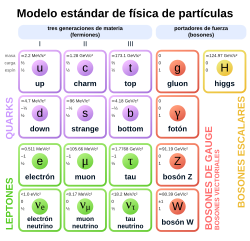Gluon
The gluon (from the English word glue 'glue', derived in turn from the Latin glūten through from French gluer 'to paste') is the boson that carries the strong nuclear interaction, one of the four fundamental forces. It is analogous to the exchange of photons in the electromagnetic force between two charged particles. It has no mass or electric charge, but it does have a color charge, so in addition to transmitting the strong interaction it also suffers from it.
The theory that postulates the existence of gluons and describes their dynamics is called quantum chromodynamics. The name alludes to "glue" (glue), since these particles are what "unite" the quarks inside the nucleons.
Properties
Like the photon, the gluon is a massless boson with spin 1. Like quarks, gluons have color charge, which depends on the color change of the quarks.
Quarks change color when gluons are exchanged, in such a way that the total color charge of the system formed by the quark and the gluon, before and after emission or absorption is the same.
For example, if a red quark turns blue when emitting a gluon, then it is because it emits a red-antiblue gluon (the red part of the gluon is the red that loses the quark, and the antiblue is to cancel out the blue that the quark wins). The system has red net color charge.
There are also 8 types of gluons, each being a color-anticolor combination. Quarks and gluons form composite particles with a neutral overall color charge (composite particles are often said to be white).
The mass of hadrons
The gluons are also part of the hadrons, and the energy of the color field they create is responsible for most of the mass of the same (E=mc2){displaystyle (E=mc^{2})}. In the case of proton you can see that:
mu+mu+mdI was. I was. mp3+3+6I was. I was. 938(MeV/c2){displaystyle m_{u}+m_{u}+m_{d}neq m_{p},,,,,,,3+3+6neq 938,({mbox{MeV/c}}}{2}}}}}
So much of the mass of the proton is attributable to the energy of the color field.
Behavior of gluons
Quark confinement
By undergoing their own interaction, the gluons that bind the quarks create a colored Yang-Mills field that prevents the quarks from separating with immense force, for small distances the field appears to decay in intensity, but for distances of the order of the size of a nucleon the force is much greater than the electrostatic forces of repulsion between protons. The formation of these bonds by gluons limits the field of action of this interaction to an order of 10-15 meters (more or less the size of an atomic nucleus).
Unlike the electric or gravitational force, if you try to separate a pair of quarks from each other, the color field pulls them with much more force; it is as if the quarks were joined by a "gluon spring", which tries to return to its initial length. Because of this, quarks and gluons are very difficult particles to detect, and we can only see the particles they make up, the hadrons.
When two quarks are separated by this spring, so much energy is accumulated in the system that it is easier for it to create new quarks to return the field of color to a less energetic state. This is the result of converting part of the energy of the field of color into new matter (E=mc2){displaystyle (E=mc^{2})}.
Residual strong nuclear interaction
Although hadrons have a neutral color charge, quarks of different hadrons can attract each other very strongly, in the case of nucleons even stronger than electromagnetic. This force of a strong nature between different hadrons is called residual, and it is responsible for the stability of the atomic nucleus despite the large number of positive charges it possesses.
This residual force can be roughly described by a Yukawa field that represents an interaction mediated by pions that are massive particles, which would explain that the nuclear force decays much faster than the inverse square law, being the intensity of this virtually zero force outside the atomic nucleus.
Gluon field
The mathematical description of the interaction of gluons with each other and with quarks is described by quantum chromodynamics. In this context, gluons are described as a gluon field that is a Yang-Mills field associated with a gauge symmetry of the SU(3) type. The Lagrangian that describes the interaction of gluons with each other and with quarks is given by:
LQCD=q! ! iγ γ μ μ ▪ ▪ μ μ q− − q! ! mq− − gq! ! γ γ μ μ Δ Δ aGμ μ aq− − 14Gμ μ .. aGaμ μ .. {cHFFFFFF}{cHFFFF}{cHFFFFFF}{cHFFFF}{cHFFFF}{cHFFFF}{cHFFFFFF}{cHFFFFFF}{cHFFFF}{cHFF}{cHFF}{cHFF}{cHFF}{cH00}{cH00}{cHFFFFFF}{cH00}{cH00}{cH00}{cHFFFF}{cH00}{cH00}{cHFFFFFFFFFFFF}{cH00}{cH00}{cH00}{cH00}{cH00}{cH00}{cHFFFFFFFFFF}{cHFF}{cHFF}{cH00}{cH00}{cH00}{cH00}{cH00}{cHFFFF}{
Where the intensity of the gluon field is given by the antisimetric tensor or 2-form Gaμ μ .. {displaystyle scriptstyle G_{a}^{mu nu }}}, while the spatial distribution of the quarks is given by the multicomponent thorn q{displaystyle scriptstyle mathbf {q} }.
For more information
- A. Ali and G. Kramer (2011). «JETS and QCD: A historical review of the discovery of the quark and gluon jets and its impact on QCD». European Physical Journal H 36 (2): 245-326. Bibcode:2011EPJH...36..245A. S2CID 54062126. arXiv:1012.2288. doi:10.1140/epjh/e2011-10047-1.
Contenido relacionado
Strong nuclear interaction
Dough
Baria





